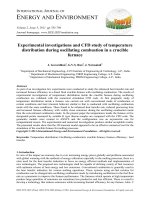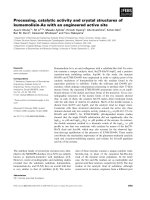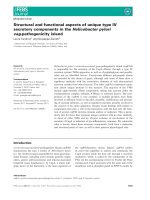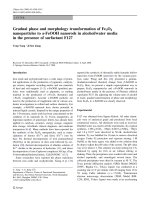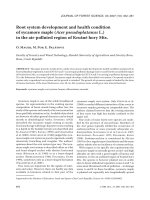Can the subaltern play postcolonial transition and the making of basketball as the national sports in the philippines
Bạn đang xem bản rút gọn của tài liệu. Xem và tải ngay bản đầy đủ của tài liệu tại đây (1.35 MB, 245 trang )
CAN THE SUBALTERN PLAY?
POSTCOLONIAL TRANSITION AND THE MAKING OF
BASKETBALL AS THE NATIONAL SPORTS IN THE PHILIPPINES
BY
LOU APOLINARIO ANTOLIHAO
(MA, Ateneo de Manila)
A DISSERTATION SUBMITTED
IN PARTIAL FULFILLMENT OF THE REQUIREMENTS
FOR A DEGREE OF
DOCTOR OF PHILOSOPHY IN SOCIOLOGY
NATIONAL UNIVERSITY OF SINGAPORE
2009
i
ACKNOWLEDGEMENTS
Just like scoring in a basketball game, writing a dissertation involves the selfless effort of
other players and coaches who made sure that the shooter has a clear look of the goal to
complete the play. At various stages in conceptualizing the research, in data gathering,
writing the dissertation, and in my everyday life as an aspiring scholar, I was a recipient
of various forms of assistance, intellectual stimulation, and warm encouragement from
colleagues, teachers, and friends to whom I am very grateful.
My heartfelt thanks to Anne Raffin, my PhD supervisor for patiently going through my
drafts. Deenesh Sohoni, Misha Petrovic, Maitrii Aung-Thwin, Daniel Goh, and Reynaldo
Ileto; members of my dissertation committee, were helpful in the initial drafting of my
research plan and in the final reconstruction of my dissertation. The wisdom and
guidance of my teachers and mentors, both in Manila and Singapore; Hing Ai Yun, Tong
Chee Keong, Maribeth Erb, Bryan Turner, Habibul Khondker, Chua Beng Huat, Eric
Thompson, Reynaldo Ileto, Goh Beng Lan, Wilfredo Arce, Emma Porio, Manuel Diaz,
Ricardo Abad, Fernando Zialcita, Raul Pertierra, Germelino Bautista, and Filomeno
Aguilar, Jr., have left a welcome influence on my thinking.
I have also benefited from my conversations and correspondence with Ho Kong Chong,
Chou Younghan, Mahar Mangahas, Apolinario Ty, Alrico Alegre, Marc de Borja, and
Albert Alejo.
ii
My Pinoy friends in NUS: Roland Tolentino, Merce Planta, Nikki Briones, Trina Tinio,
Jun Cayron, Nathan Cruz, Andie Soco, Niño Leviste, Rommel Curaming, Julius Bautista,
and Rica Sauler were the best companions I could have ever hoped to have. Thanks also
to my fellow graduate students, especially to Magdalene Kong, Devi Ramasamy, Kaoko
Takahashi, Genevieve Duggan, Yang Chengseng, Zhou Wei, Nick Sim, Seuty Sabur,
Taberez Neyazi, Saiful Islam and Sarbeswar Sahoo for the fruitful exchange and the
many memorable times we shared.
I also thank the National University of Singapore for affording me a supportive academic
environment and an ideal place to work on this project. The University’s Graduate
Research Support Scheme provided funds that allowed me to do research in the United
States as well as in the Philippines. NUS also provided financial support for me to
participate in a conference in Australia in July 2008 where I had the opportunity to
explore the field of sport studies beyond my current research.
I am grateful for the assistance of archivist and librarians at the US National Archives
and Record Administration, the Library of Congress, Bentley Historical Library at the
University of Michigan-Ann Arbor, Kauts Family YMCA Archives at the University of
Minnesota, Bancroft Library at the University of California-Berkeley, Rizal Library at
Ateneo de Manila University, the University of the Philippines Main Library, University
of the Philippines’ College of Human Kinetics Library, University of the Philippines’
Vargas Museum and Filipiniana Research Center, the Philippine National Library,
Philippine Sports Commission Library, and the Social Weather Stations.
iii
I have presented portions of this work in a number of workshops and conferences in New
York, Beijing, Manila, Singapore, Moscow, and Melbourne. Particularly, the 2008 ISA
(International Sociological Association) Laboratory for PhD Students in the Russian
capital provided an opportunity to present my initial findings in a select group whose
members came from eleven countries, and from an equally diverse theoretical and
methodological backgrounds. Bal’shoye spaciba to Isabela Barlinska, Nikita Pokrovsky,
Tatiana Venedictova, Maria Soukhotina, Valentina Shilova, Stephen Brier, Marcel
Fourneir, and Michael Burawoy – the workshop facilitators; as well as to my fellow
participants Francisco Caminati, Vishal Jadhav, Asuka Kawano, Zharaa McDonald,
Claudia Mullen, Daniel Woodman, Anna Chursina, Tanya Butnor, Vera Bobkova, Alla
Vaselova, and Holland Wilde for the long but exciting days of intellectual exchange as
well as for the blinys, baltikas, and other unforgettable things that we shared in Moscow.
Above all, I want to thank my wife Nona and my son Luis, who was timely born just days
after I completed the first draft of this manuscript, for their love and inspiration. My
parents and the rest of my extended family has been a constant source of joy, affection,
and encouragement.
iv
CONTENTS
Acknowledgement i
Table of Contents iv
Abbreviations vi
List of Figures vii
List of Tables viii
Summary ix
Map of the Philippines xi
1 Introduction
Playing With the Big Boys 1
Can The Subaltern Play? 6
Hoops Hysteria 12
Playing With the Big Boys 15
The Promise of Growth 22
The Game Plan 32
2 Spheroid of Influence
Basketball, Colonization, Modernity 38
“Unfit” for Self-Government 42
Race, Athletics, Americanization 44
From Tribal War to Tug-of-War 47
Body Politic: Sport, Masculinity, Citizenship, Modernity 52
Ballers in Bloomers: Sport and Gender Issues 62
From Evangelization To Exercise Instruction 67
Play and Display: Sport Events as Colonial Spectacles 72
3 From Baseball Colony To Basketball Republic
Postcolonial Transition and the Making of a National Sport 78
The Rise and Fall of Baseball 81
Space Jam: The Geography of Games 88
The Battle of Ballgames 91
The Invader vs. The Innovator 96
Rural Baseball vs. Urban Basketball 97
Inter-scholastic Baseball vs. Collegiate Basketball 100
Popular Pastime vs. The Bourgeois Ballgame 102
Sports and the Nation 105
Sport Participation and International Recognition 106
“Competitive Advantage” and Regional Politics 110
v
4 The Hollywoodization of Hoops 113
Basketball, Mass Media, Popular Culture
Basketball, Popular Culture, and the Cold War in Asia 117
The Hollywoodization of Philippine Basketball 122
Play For Pay: Mimicry, Identity, and Professionalization 123
Basketball in a Box: Sport, Television, Mass Media 128
From Cagers To Celebrities 132
The League and The Nation 135
From National To Popular 138
5 Rooting for the Underdog
Sport, Spectacle, Subalternity 143
From Fowl Game To Foul Team 146
Diversion and Defiance in Colonial Pastime 147
The Team of The Masses 150
Play Basketball and Be a Senator 152
The Team of Fouls 154
When Ginebra Losses: The Subaltern Struggle as a Spectacle 154
When Ginebra Wins: Sport Victory as Symbolic Emancipation 165
6 Basketball Without Borders
The National Sport in the Global Arena 176
Power Moves: Basketball, Globalization, Postcolonialism 181
The Global Sport and the Local League 184
From Fil-Ams To Fil-Shams 185
The External Threat: The Increasing Popularity of the NBA 190
The Internal Threat: The Rise of Local Amateur Leagues 193
The Regional Challenge: The Asian Basketball Superiority 194
Playing With Globalization 197
A Different Ballgame 201
7 Conclusion 207
Why is Basketball Popular? 211
Basketball From Below 216
Basketball and Beyond 218
Bibliography 223
vi
ABBREVIATIONS
AHC American Historical Collection, RL-ADMU
BHL-UMI Bentley Historical Library, University of Michigan
FECG Far Eastern Championship Games
FIBA Federacion Internationalé du Basketball
MBBL Manila Bay Baseball League
MICAA Manila Industrial and Commercial Athletic Association
NARA National Archives and Records Administration (US)
NCAA National Collegiate Athletic Association
NBA National Basketball Association (US)
PAAF Philippine Amateur Athletic Federation
PBA Philippine Basketball Association
PNL Philippine National Library
RG Record Group
RL-ADMU Rizal Library, Ateneo de Manila University
UPML University of the Philippines Main Library
UPVM University of the Philippines Vargas Museum
US-LOC United States Library of Congress
YMCA Young Men’s Christian Association
YMCA-UMN Kauts Family YMCA Archives, University of Minnesota
vii
FIGURES
1 Map of the Philippines xi
2 Filipino vs. Americans Editorial Cartoon 5
3 The Internal Revenue Team, 1916 National Champion 25
4 Photo of Dean Worcester with an indigenous Filipino 46
5 Indigenous Filipinos playing baseball 48
6 Postcard showing a girl’s basketball match in 1910. 65
7 Early 20
th
century Philippine YMCA personnel. 69
8 The official logo of the Far Eastern Championship Games. 73
9 A baseball match during the 1913 Far Eastern Games in Manila. 84
10 Philippines-Uraguay match at the 1936 Berlin Olympics 108
viii
TABLES
1 Most Popular Sports in the Philippines 13
2 Average Human Height in the Philippines and Selected Countries 17
3 Winners of the National Basketball Championship (1911-1923) 93
4 Winners of the National Open Championship (1924-35) 94
5 Asian Baseball and Basketball Championships Winners, 1950s-1960s 111
6 Basketball Results in the Asian Games 196
ix
SUMMARY
This study examines the convergence of the concepts of subalternity and postcolonialism
in the context of the formation of a national sporting culture in the Philippines. In
particular, the historical-sociological inquiry looks into the origins of basketball’s
introduction and popularity, the patterns of its spread and significance, and its
relationship with the formation of the Philippine nation-state in the 20
th
century. The
analysis centers on how basketball developed from a colonial implant to a popular
national pastime through a set of complex and contradictory processes that paralleled the
emergence of a national consciousness. Hence, basketball is generally seen as an
abundant repository of countless events and narratives, of various symbols and
representations that provides an opportunity for a unique perspective in understanding
some important aspects of Philippine history, culture, and society.
The first chapter presents the rationale of the study and the objectives that it aspires to
complete. It will also provide a brief discussion of the changing nature of the relationship
between sport and society and how it is being analyzed and articulated by various
scholars. Focusing on the American colonial period, Chapter Two attempts to reconstruct
the beginning of Philippine basketball by tracing its location in the larger colonial
dynamics through the analysis of specific policies and the prevailing ideologies and
overall sentiments regarding US imperialism, and its occupation of the Philippines. It also
explores the relationship between physical education and sports through several issues
such as race, religion, and sovereignty that defines the general social condition of this
x
particular historical period. Chapter Three examines the celebrated rivalry between
baseball and basketball as the premier sporting pastime in the country from the early
American colonial era up to the period shortly after the Second World War. Generally,
the close association of baseball with the American as an “occupation force”, in contrast
to basketball’s general image as a representation of the “benevolent America” has
resulted into the decline of the former and the rise of the latter.
Furthermore, Chapter Four looks into the “Hollywoodization of Hoops”, which described
the process that turned the country’s premier basketball league into an important aspect
of the local entertainment industry. It focuses on how the Philippine Basketball
Association (PBA) capitalized on its popularity as a primetime television spectacle and
its celebrity-studded teams to sustain the game’s prominence in the local sports scene
despite its mediocre performance in international competitions. Chapter Five provides a
view of basketball from the rafters. “Rooting for the Underdogs” explores the connection
between sport, spectacle and subalternity by tracing how basketball is used as a metaphor
to portray the general social predicaments of many Filipinos who endured a long period
of colonization, marginalization, and poverty. Chapter Six deals with the impact of
globalization on Philippine basketball. Primarily, it describes how the expansion of the
American basketball empire has contributed to the decline of the local professional
league at the turn of the millennium. Finally, the last chapter concludes by emphasizing
the theoretical contribution of the study in the sociology of sport science, as well as in the
fields of postcolonial and subaltern studies.
xi
Figure 1. Spheroid of Influence: A highly publicized map of the Philippines
circulated during the annual Manila Carnival (1908-1939). It depicts the country
inside a basketball-shaped sphere emphasizing its strategic location for development
as the commercial and cultural hub of Asia. RG 350-E5-5453-99A US NARA.
1
CHAPTER ONE
INTRODUCTION
Playing With The Big Boys
Tatangkad din ako! (I, too, shall be tall!), is the trademark catchphrase in a series of
television commercials promoting a brand of children multi-vitamin supplement in the
Philippines. The brand distinguishes itself through a unique formula that apart from
giving the necessary nutrients also promises to enhance the growth of young children.
Fittingly enough, when the first version of the advertisement series came out in 2006, it
was intended to have basketball as its main theme. Designed like a hip-hop MTV music
video, the television commercial shows a group of five young kids doing a song and
dance performance. During the routine, the youngsters are shown proficiently executing
different basketball tricks and even exhibiting a particular skill that is a rare sight in
Filipino basketball games: dunking the ball. By creatively stitching together different
elements of contemporary Filipino youth culture (hip hop, MTV, and basketball), the
advertisement became one of the most popular television commercials; its jingle evolved
into a popular children’s song and over a short time, the advertising slogan itself
developed into a familiar everyday adage.
Beyond its marketing success, Tatangkad din ako! presents some interesting insights into
contemporary Philippine society. Notably, it reflects the country’s obsession for “adding
some extra inches” as shown in the popularity of growth enhancement formulas that,
aside from coming in food supplements, are also added in milk, sandwich spread,
2
hotdogs, and other food products. Likewise, the television commercial has also shown
that this obsession for growth is largely associated with the Filipinos’ other obsession: the
sport of basketball. Basketball has gone a long way since it was first introduced by US
soldiers and missionaries during the early period of the American colonial period at the
turn of the twentieth century. Currently, the ubiquitous presence of hardcourts and
makeshift hoops across the country and the extensive coverage that basketball attracts
from television and other forms of mass media are testaments of how deeply it has taken
roots as the most popular participatory and spectator sport in the Philippines.
In a larger context, Tatangkad din ako! illustrates the main theme that is central to this
research project: the relationship between sports and postcolonial/subaltern societies.
Throughout history, sports act as means by which imperialist societies exercise informal
yet equally transformative influence while simultaneously providing the mechanism for
subaltern groups to mobilize resistance and assert their own identity.
1
In the Philippines,
basketball stands both as a symbol of nationalism and as a remnant of its colonial past.
For instance, the Philippine basketball team’s credible showing (a controversial fifth-
place finish)
2
1
James H. Mills, Subaltern Sports: Politics and Sport in South Asia, (London: Anthem
Press, 2005).
at the 1936 Berlin Olympics two years after the country acquired a limited
2
The Philippines’ fifth place standing became a subject of controversy because their 4-1
win-loss record was better than fourth place Poland (1-2), third place Mexico (3-2) and
even second place Canada (3-1). The Philippines even defeated the Mexican team in their
encounter with a come-from-behind 32-30 score. It was the first time that basketball was
played at the Olympics and a loophole in the bracketing system was overlooked resulting
in the issue with ranking. This problem was later corrected for the subsequent Olympic
Games. See Jorge Afable (ed.), Philippine Sports Greats, (Mandaluyong City: MAN
Publishers, 1972).
3
self-governing power through the Philippine Independence Act
3
became a source of
national pride and a means to promote international recognition for the emerging
sovereign nation. Before this event, the country had already won nine out of the ten
basketball championships in the Far Eastern Games (1913-1934). Subsequently, a third
place finish at the World Basketball Championships in 1954 and four straight Asian
Games championships from 1951 to 1962 cemented the position of basketball as the
country’s “national sport”
4
. However, despite its importance as a symbol of the nation’s
emergence, the popularity of basketball in the Philippines remains as an enduring mark of
the country’s subalternity. The country, for example, has been criticized largely for
“blindly” following an American game that generally does not suit the physical make up
of the Filipinos. This criticism has even become more cogent with the current mediocre
standing of the Philippines in top international basketball competitions.
As an American colonial implant, basketball represents the Philippine’s ambiguous
relationship to its former colonial master. At one hand, the game illustrates the Filipinos
3
More popularly known as the Tydings-McDuffie Act, the Philippine Independence Act
is the piece of legislation that established the Commonwealth of the Philippines, a ten-
year transitional government in preparation for full Philippine independence and
sovereignty. Under this arrangement, the Filipinos were able to enact its own constitution
and elect its own executive and legislative officials. Although foreign policy and military
affairs would be under the responsibility of the US, certain legislation still requires the
approval of the American president. See Julian Go and Anne Foster (eds.), The American
Colonial State in the Philippines: Global Perspectives, (Pasig City: Anvil Publishing
Inc., 2005).
4
The word “national sport” is often synonymously equated with “national pastime”,
which refers to a sport that has a widespread and fervent following in a particularly
society. However, in the Philippines, it is necessary to distinguish basketball as a national
sport with the country’s official sport, which is sipa. Sipa is a traditional team sport,
similar to sepak takraw that basically involves kicking a ball made of rattan back and
forth over a net in the middle of the court.
4
ability to integrate some of the “modern ways” that the American colonial regime tried to
establish through its various development programs, including sports and physical
education. The national team’s early success in international basketball competitions, for
instance, was used not only to legitimize the widespread plea for Philippine sovereignty
but was also employed to promote the achievements of the American “tutelage”
5
… the Philippines were then under American rule and far more influenced by
American sports than the Chinese or the Japanese, it was hardly a surprise that the
home team, which greatly outnumbered the visitors, won most of the events,
including the basketball championship.
of the
Filipinos. According to Guttman, the country’s victory was attained because:
6
In fact, when the Philippines beat a strong Israeli team at the 1952 Olympic Games in
Helsinki, the victory was described as a demonstration of “the influence of countless
United States service teams that have played there.” In addition, the writer boasted about
how “[t]his was another example of how the US, through associations like the YMCA
and through its military posts, had helped bolster basketball’s popularity [in the country]
”.
7
5
After crushing the First Philippine Republic during the Philippine-American War, the
US justified their continued control by claiming that the Filipinos are still unfit for
independence. The Americans then, implemented a process of “benevolent assimilation”
where a democratic government patterned after the American system was instituted. The
Filipinos were basically tutored in the intricacies of governance while gradually given the
responsibilities in running the state affairs until full independence was granted. See
Stanley Karnow, In Our Image: America’s Empire in the Philippines, (New York:
Random House, 1989).
However, when the Philippines, later on, failed to sustain its high standing in
international basketball competitions, the series of losses were often used as a sign of
regression.
6
Allen Guttmann, Games and Empires: Modern Sport and Cultural Imperialism,
(New York: Columbia University Press, 1994): 102-03.
7
Carson Cunningham, American Hoops: The History of United States Olympic
Basketball from Berlin to Barcelona, PhD Dissertation, Purdue University, 2006: 194.
5
Figure 2. A 1990 editorial cartoon showing a caricature of a Filipino player standing
in front of towering American hoopsters. Take note of the name of famous US
Dream Team members (Jordan, Johnson, and Ewing) on their uniforms. Figure
reproduced from Sports Flash Vol. 6, No. 299 (April 13-19, 1989): 9. Periodicals
Section, RL-ADMU.
The country’s lack of success in maintaining its high ranking in international basketball
competitions from the 1930s to the 1960s is often used to portray the Philippines’ overall
decline that is more evident in its failure to sustain its promising economic growth during
the early post-WWII period. Moreover, both the basketball and economic failures are
largely seen to reflect the colony’s inability to propagate the seeds of modernity that were
planted during the American regime. Hence, the Philippines’ shortcomings in
maintaining a lofty international standing in a game that has been considered as its
national sports represents the inherent limitations (e.g. height) that hinder the country’s
progress as a nation. At present, the criticisms against the country’s mediocre
6
performance in international basketball competitions has threatened its legitimacy as the
“national sport” and its continuing decline has turned the game from a source of pride
and inspiration into a perennial cause of disappointment and national shame.
Yet, the resilience of basketball in keeping its primary position in Philippine sports
despite its dreaded mediocrity and the resulting criticisms thrown at its way is simply
remarkable. This “audacity of hoop” illustrates how the sport is deeply entrenched in the
Filipino culture that despite the serious quagmire where it is in now, basketball is still
considered as a bearer of hope. Countless Filipino basketball fans, despite their
frustrations, are still optimistic that a future success in basketball could signal the
country’s long-waited resurgence. Again, the multi-vitamin advertisement shows this
remarkable sense of hope that Filipinos have bestowed on the shaky hands of their
basketball players. Tatangkad din ako! or “I, too, shall be tall!” can easily be understood
as an optimistic expression that the country will someday experience “growth”. However,
the preoccupation with “getting tall”, as reflected by the naïve kids singing and dancing
in the television commercial, can be just another absurd obsession with something that,
for Filipinos, is really impossible to achieve.
CAN THE SUBALTERN PLAY?
The project focuses on the history and culture of basketball in the Philippines. The sport’s
important location in Philippine society brings about various practical and theoretical
issues, which inform current discourses in the sociology of sport as well as in the larger
domains of historical sociology, cultural studies, and postcolonial studies. Particularly,
7
the research aims to achieve the following goals: 1) to give an historical account of the
origin of basketball’s introduction and popularity in the Philippines; 2) to illustrate the
patterns of its spread and significance; 3) to examine the development of the sport in
relation to the larger socio-cultural dynamics in the different periods of the country’s
history; and 4) explore its relevance and contributions to the various discourses on
imperialism, state-building, and subalternity.
With these objectives, the study views basketball as an abundant repository of countless
events and narratives, of various symbols and representations that provide an opportunity
for a unique perspective in understanding some important aspects of Philippine history,
culture, and society. How did Philippine basketball evolve from a colonial game to a
popular national sporting culture? What are the rationalities behind the extraordinary
popularity of basketball among the Filipinos? How are the meaning, organization, and
purpose of basketball connected with the local material conditions, social relations, and
cultural traditions? Clearly, such questions invite a closer look at the complex relations
between imperialist sport cultures and the local cultural rationalities, and the ways in
which they are dialectically and historically informed.
Expanding the game to the larger playing field, which straddles the realms of imperialism
and subaltern studies, the dissertation, argues that Philippine basketball reflects the
subaltern predicament of “playing with the big boys”. Literally, this concept illustrates
the dilemma that relatively shorter Filipino players (see Table 2) experience in competing
against tall and athletic opponents when they play the country’s “national game” in
8
international competitions. In metaphorical sense, “playing with the big boys” generally
embodies the struggles, the joys of playing, the thrills of victory, and the frustrations of
losing that the Philippines, as a subaltern society, experiences in its relationship with
imperialist powers, especially in its relationship with the United States, the country’s
former colonial master and the current global hegemonic power.
The concept of subalternity here originates from the work of Ranajit Guha on the
historiography of colonial India.
8
[l]ies in its recognition of the ‘autonomous domain’ of the subaltern agent or
agents. While dominated, the subaltern is not entirely obliterated and retains
values, ideas and modes of action that are not prescribed by the dominant and
which can draw upon beliefs and experiences exclusive to the individual or
group. In other words the subaltern always has the potential to oppose or resist
the dominant as he or she may draw upon alternative values and ideas and can
refer back to different experiences and behavioral expectations.
Following Guha’s definition, James Mills, in his
introduction to the edited volume titled “Subaltern Sports”, referred to the term subaltern
as “the dominated party in any power relationship [while] the study of subalternity is of
relationships characterized by ‘dominance without hegemony.’” Thus “[t]he importance
of the concept of subalternilty”, he explain further:
9
Subalternity, in this particular study, covers a broad range of spectrum. Primarily, the
term is used to represent the position of the Philippines (and the Filipinos) as a colonial
and neo-colonial subject/s that has been continually exposed to the political, economic,
and cultural dominance of the United States as its colonial master and eventually as the
hegemonic global power in the twentieth century. Beneath this overarching level of
8
Ranajit Guha, “On some aspects of the Historiography of India”, in R. Guha (ed.),
Subaltern Studies I (Delhi: Oxford University Press, 1982).
9
Mills, Subaltern Sports, 1.
9
interaction, however, the word “subaltern” also analogously refers to Philippine
basketball, in general, and in its various characterizations as a representation of the
nation/society, or in reference to particular marginalized Filipino basketball players,
teams, and fans discussed in the coming chapters.
Conceptually, this study tries to understand the subalternity of Philippine basketball
following a postcolonial approach. Postcolonialism, following the definition of John Bale
and Mike Cronin, is used to refer to particular time periods (colonial, post-independence,
global), a subject of analysis (postcolonial sport as a series of historical and social
phenomenon), and as a theory.
10
As a theoretical framework, it follows the “post-binary”
approach that is particularly gaining more following in the fields of postcolonial and
subaltern studies. This analytical viewpoint, according to historian Douglas Booth,
“attempts to break down the tendency in Western thought to dichotomize natural and
social phenomena, and to describe and define them in terms of oppositional
characteristics and neutrally opposed terms”.
11
In sport studies, this approach explores
the spaces between oppositional poles, particularly in the empire-colony dichotomy to
analyze the development of sporting cultures in postcolonial societies.
12
10
John Bale and Mike Cronin (eds). Sport and Colonialism. (Oxford: Berg, 2003).
Although postcolonialism literally means “after colonialism”, Bale and Cronin pointed
out how, “most works espousing a postcolonial approach deal with the period of
colonization and imperialism (ibid, 3). This study generally follows this system of
periodization.
However, this
11
Douglas Booth, The Field: Truth and Fiction in Sport History, (London: Routledge,
2005): 16.
12
For a good example of how the post-binary approach is utilized to analyze the
dynamics of postcolonial sport, see Arjun Appadurai, “Playing with Modernity: The
Decolonization of Cricket,” in, Modernity at Large: Cultural Dimensions of
10
specific study on Philippine basketball distinguishes itself from the current literature in
post-binary theorizing by introducing a multi-dimensional feature to explore relational
junctures beyond the empire-colony binary. Instead of merely refocusing on hybrid
cultural forms, the objective of this historical-sociological inquiry is also to go beyond
the mere examination of the exercise of power and resistance between the colonized and
the colonizer to incorporate other players, related processes and their rationalities.
Particularly, the project tries to come up with a comparative investigation of the
development of basketball in the Philippines within the Asian context, by using similar
cases and comparable processes regarding the growth of modern sports in 20
th
century
China and Japan.
This framework specifically attempts to incorporate the history of American colonialism
in the Philippines within the larger process of the “Americanization of Asia” which
started in the mid-nineteenth century. Basically, the study argues that apart from the
influence of the United States, the Filipinos’ engagements with Chinese and Japanese
basketball teams and their rivalry as emerging Asian nations in the early 20
th
century also
contributed to the growth of basketball in the Philippines. As such, “playing with the big
boys” suggests a multi-dimensional framework. Instead of narrowing its focus on the
space between oppositional entities for hybrid cultural forms, it tries to explore other
range of comparisons that can give meaning for the persistence of certain colonial
cultural practices and the appearance of new ones in contemporary geopolitical dynamics.
Globalization, (Minneapolis: University of Minnesota Press, 1996). Also see John Bale
and Mike Cronin (eds.) Sport and Postcolonialism, (Oxford: Berg, 2003).
11
Methodologically, the study demonstrates the efficacy of historical-sociology in looking
into the development of certain social practices in relation to the larger societies wherein
they are located. In addition, this approach gives due emphasis to the notion of time by
looking onto the relevance of certain events beyond the immediate period, highlighting
its importance as part of a larger and longer social narrative. This method is especially
useful in tracing the evolution of basketball in the Philippines from a colonial game to a
national pastime since it followed a broad chronological spectrum that paralleled the
formation of the Philippine nation-state that wound through various points of
convergence and disjuncture that essentially shaped both of their histories. The reflexivity
of this research method enabled the discussion to cover a whole range of issues in
different time periods without losing focus and coherence. In the postcolonial and
subaltern contexts, the historical-sociological approach has also been useful in tracing the
rationalities behind the existence of certain cultural practices such as basketball, that in
contemporary age have appeared to be overly ambiguous or even socially irrelevant.
Thus with the currently puzzling question of Why is basketball popular in the
Philippines? the study was able to come up with a relatively substantive answer by
examining how the sport developed throughout the 20
th
century.
Finally, this study hopes to help fill the dearth of literature in Philippine sports. Despite
the significant role that it has played in shaping its history, culture, and society, this
specific subfield remains a vast frontier that has largely remained unexplored. Sport, in
general, reflects embedded social dynamics that are often buried under larger political
and economic issues. Sports are, in some ways, microcosms of the societies in which they
12
are located, and a closer look into them “produces a blueprint of those important and
valued behaviors that are the foundation of the larger culture in which the sport is
embedded”.
13
Thus looking into the social history of basketball will not only help to give
a better understanding of the importance of basketball in the Philippines, but will also
provide important insights on the overall dynamics of Philippine culture and society.
HOOPS HYSTERIA: BASKETBALL AS A HEGEMONIC SPORT CULTURE
In a research that deals with the convergence of culture and power, Markovits and
Hellerman’s concept of “hegemonic sports culture” offers a pertinent framework in
understanding the importance of basketball in Philippine society.
14
Their emphasis on
“emotional attachment”
15
in evaluating the importance of a particular sport in a society
articulates the “hoops hysteria” that generally characterizes the fervent and pervasive
interest in basketball across the country.
Studies in recent years provide glimpses to the extent of basketball’s mass appeal. For
instance, shortly before the 2005 SEA Games (Southeast Asian Games) in Manila, a
survey was conducted to ask respondents to make a list of sports that the Philippine sport
teams expect to win. Basketball expectedly topped the survey, emerging as the first
choice among 44 percent of the respondents.
16
13
Robert Sands, “Anthropology and Sport” in, Robert Sands (ed.) Anthropology, Sport,
and Culture, (Westport, CT: Bergin and Garvey, 1999): 3.
However, what is interesting about this
result is the fact that basketball was not even in the list of sports scheduled for the
14
Andrei S. Markovits and Steven L. Hellerman, Offside: Soccer and American
Exceptionalism, (Princeton, NJ: Princeton University Press, 2001).
15
Markovits and Hellerman, Offside, 10.
16
Social Weather Stations, Social Weather Report, August 26- Sept. 5, 2005: 100.
13
regional sport event. In addition, basketball, along with boxing, also finished on the top
of a survey that was set to determine “which sports are Filipinos good at”. Basketball and
boxing each garnered 55 percent of respondents’ votes, they were followed by billiards
and bowling with 37 and 15 percent respectively, while the rest of the sports that received
votes only scored in single digit.
17
Table 1. Most Popular Sports in the Philippines
Favorite Sports to
Play (%)
18
Favorite Sports to
Watch (%)
19
Education Dept.
Ranking
20
Male
Female
Male
Female
Male
Female
Basketball
58
9
83
64
1
2
Volleyball
22
27
18
22
3
1
Baseball/Softball
11
8
6
8
5
Swimming
6
3
2
3
Table Tennis
5
2
1
1
Bowling
4
2
1
2
5
4
Tennis
4
2
5
7
6
Boxing
3
0
21
5
Billiards
3
0
3
0
Football/Soccer
0
0
6
2
4
Track & Field
0
0
2
1
2
3
More studies (see Table 1) placed basketball on top of other sports as the favorite sport to
play as well as favorite sport to watch, particularly among male respondents. It is the
second favorite sport to play among females, although it remains as their most favorite
sport to watch. Moreover, a ranking made by teachers, students, and sport specialists
from different regions of the Philippines gathered similar results with basketball
17
Mahar Mangahas, “Its World Pool Time Again,” Philippine Daily Inquirer, Nov 3,
2007: 9.
18
Gerardo A. Sandoval and Ricardo G. Abad, “Sports and the Filipino: A Love Affair,”
Social Weather Bulletin Vol. 97, Nos. 3-4 (February 1997): 3-4.
19
Sandoval and Abad, “Sports and the Filipino,” 3-4.
20
Janice Beran, “Physical Education and Sport in the Philippines,” in Eric Wagner’s
(ed.) Sport in Asia and Africa, (New York: Greenwood Press, 1989): 147-164.
